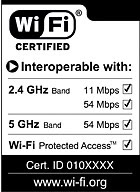Wi-fi is a microwave technology, but that obscures the fact that it's a radio technology. and it has its place in the radio portion of the electromagnetic spectrum. Microwaves are just radio waves with very short wavelengths. The wavelength of your typical AM radio signal is a thousand feet. FM radio operates at a wavelength of a little under ten feet. Wi-Fi, by contrast, works at a wavelength of 12 centimeters less than five inches. The frequency used by Wi-Fi gear is at a frequency of about 2.45 Gigahertz (Ghz), which 2.45 billion cycle per second. The key point to remember is that Wi-Fi isn't the only kid on that particular radio block The Radio spectrum between 2.4Ghz and 2.4835Ghz was Already a pretty busy place prior to 1997, when the 802.11 standard was first published, and it's gotten a lot busier with the ascendance of Wi-Fi. The Band itself goes back some years before 1997, and it was originally set aside by the Federal Comminications Commision (FCC) fot he use of industrial machinery like induction heaters (including microwave ovens), cordless phones, and various arcane medical and scientific gadgetry gathered under the description "industrial, scientific, and medical." Licenses are not required for individuals to operate ISM equipment designed for use within the band. However, manufacturers must apply for the receive type acceptance from the FCC before they can manufacture products for the band, which must adhere to fairly strict FCC requirments for power output, band use, and purity emissions.
Wi-fi gear is, like ISM equipment, unlicensed, and it also must undergo FCC type acceptance. However, Wi-Fi gear is not considered ISM equipment and doest not have any kind of priority on the frequencies it uses over ISM equipment. In fact, if a medical or industrial device causes interference to a Wi-Fi network, the network's owner has no legal recourse othe than to move to a different Wi-Fi channel, of which there are only 12.
Two other significant wireless networking technologies, Bluetooth and HomeRF, share space on this band. As with WI-FI, both are secondary uses to virtually all other uses of tha band, parts of which are used by public safety (police and fire) communications, news gathering services, seaborne and airborne radar, and numerous other things.
The allocation of the band to Wi-Fi equipment is complex. Fig 1 sample shows a diagrammatically how the band is laid out. Perhaps the most important thing to notice is that other regions of the world have a larger Wi-Fi frequency allocation than American users do. The Japanese, in particular, have the use of a full 100Mhz between 2.4 and 2.5 Ghz for 802.11b operation. American users have only the first 83.5 Mhz of that space, with Europe falling somewhere in the middle. Parts of Europe have access only to limited subsets of the band, France being the most notable example.
Wi-Fi channels are spaces 5 Mhz apart. However, the bandwidth of a Wi-Fi channel is 25 Mhz. This means that individual channels overlap with two adjacent channels in either direction. Channel 6, for example, overlaps channel 4,5,7 and 8. For American users, at least, this means that only the three channels 1,6, and 11 may be used simultaneously in the same general space without any channel interference. Channel 14 is something of an outlier and is set apart slightly from the first 13 channels. Channel 14, however, is used mostly in Japan and (along with channel 12 and 13) is not sanctioned by the FCC.
Wireless network theory background information. Radio Frequency Wi-Fi 802.11 Channel Router Setup Configuration Do-it-Yourself

